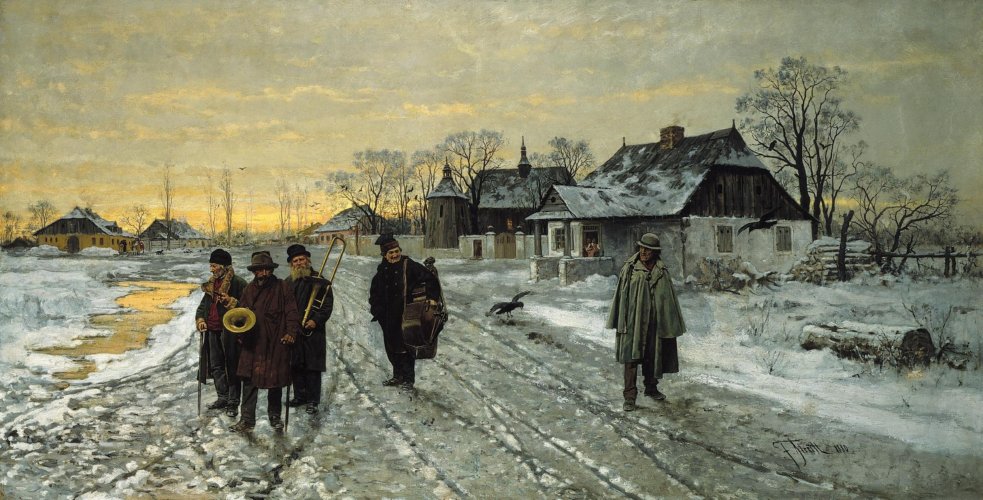Description:
Franciszek Streitt (1839-1890) graduated from the Cracow School of Fine Arts, then the Vienna Academy. In 1871 he went to Munich, where he created until his death. He was friends with Aleksander Kotsis and Zygmunt Sidorowicz. Initially he created historical paintings, but under the influence of Munich art he devoted himself to genre painting*.
Description of the Picture:
The painting depicts a winter scene of a Polish village. In the foreground there are five figures walking through the center of the village. On the left edge of the canvas is a group of the title wandering musicians. The figures are dressed in dark, long coats. The man walking in front holds a horn in his right hand and a cane in his left with which he is leaning on. From under the shadow of his hat he looks forward, as if looking at the viewer. The musician behind him, on the left, is also leaning on a cane and is holding a flute under his left armpit. His face is uncovered and turned to the left. The third man holds a trombone. He looks directly at the viewer, his face is bright, surrounded by a beard, and his head is covered with a black hat. To the right of the described group, in the center of the painting, is a man dressed in black carrying a double bass across his left shoulder. His head is turned to the right, establishing eye contact with the last figure in the foreground – the man in the gray cloak who looks at the musicians with curiosity. The figures are moving towards the viewer on a road covered with melting snow and ice, with clearly visible wheel tracks. It crosses the village which is the background for the men. On the left edge of the painting, in the puddles of melted snow, the light of the setting sun is reflected. In the distance a yellow building is visible, in front of which stand several figures and a dog. It is possible that it is an inn from which the wanderers have just left. Behind it is the silhouette of a farm. On the right edge of the painting a house is visible, from the threshold of which two women look out, looking after the departing men. Behind the house there is a wooden church and the diminishing outlines of more farms. Above the village looms the characteristic for Munich sky gray–blue sky, interspersed with shades of yellow and orange of the setting sun.
In the picture a converging side perspective was used, which gives it depth. It was created in the style of realism, with great detail. Men are portrayed realistically, their features are clear, emphasizing their age. The landscape in the background is rich in details such as small figures moving around the village, smoke coming from the chimneys of houses and lights in the windows, outlines of trees and flocks of birds.
This scene depicts the everyday life of a rural village. The landscape shows the typical look of a contemporary village, with the church and inn at its center. The wandering musicians become an attraction for the villagers, as evidenced by the looking women from the houses, or the man who looks at the musicians, perhaps engaging in dialogue with them. The placement of the group of musicians against the background of the running road, rather than the houses, as well as the man on the right, emphasizes the character of their life – a continuous journey from village to village, playing in inns or on squares to earn a living and make time for the villagers.


